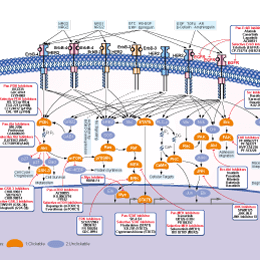
- Bioactive Compounds
- By Signaling Pathways
- PI3K/Akt/mTOR
- Epigenetics
- Methylation
- Immunology & Inflammation
- Protein Tyrosine Kinase
- Angiogenesis
- Apoptosis
- Autophagy
- ER stress & UPR
- JAK/STAT
- MAPK
- Cytoskeletal Signaling
- Cell Cycle
- TGF-beta/Smad
- Compound Libraries
- Popular Compound Libraries
- Customize Library
- Clinical and FDA-approved Related
- Bioactive Compound Libraries
- Inhibitor Related
- Natural Product Related
- Metabolism Related
- Cell Death Related
- By Signaling Pathway
- By Disease
- Anti-infection and Antiviral Related
- Neuronal and Immunology Related
- Fragment and Covalent Related
- FDA-approved Drug Library
- FDA-approved & Passed Phase I Drug Library
- Preclinical/Clinical Compound Library
- Bioactive Compound Library-I
- Bioactive Compound Library-Ⅱ
- Kinase Inhibitor Library
- Express-Pick Library
- Natural Product Library
- Human Endogenous Metabolite Compound Library
- Alkaloid Compound LibraryNew
- Angiogenesis Related compound Library
- Anti-Aging Compound Library
- Anti-alzheimer Disease Compound Library
- Antibiotics compound Library
- Anti-cancer Compound Library
- Anti-cancer Compound Library-Ⅱ
- Anti-cancer Metabolism Compound Library
- Anti-Cardiovascular Disease Compound Library
- Anti-diabetic Compound Library
- Anti-infection Compound Library
- Antioxidant Compound Library
- Anti-parasitic Compound Library
- Antiviral Compound Library
- Apoptosis Compound Library
- Autophagy Compound Library
- Calcium Channel Blocker LibraryNew
- Cambridge Cancer Compound Library
- Carbohydrate Metabolism Compound LibraryNew
- Cell Cycle compound library
- CNS-Penetrant Compound Library
- Covalent Inhibitor Library
- Cytokine Inhibitor LibraryNew
- Cytoskeletal Signaling Pathway Compound Library
- DNA Damage/DNA Repair compound Library
- Drug-like Compound Library
- Endoplasmic Reticulum Stress Compound Library
- Epigenetics Compound Library
- Exosome Secretion Related Compound LibraryNew
- FDA-approved Anticancer Drug LibraryNew
- Ferroptosis Compound Library
- Flavonoid Compound Library
- Fragment Library
- Glutamine Metabolism Compound Library
- Glycolysis Compound Library
- GPCR Compound Library
- Gut Microbial Metabolite Library
- HIF-1 Signaling Pathway Compound Library
- Highly Selective Inhibitor Library
- Histone modification compound library
- HTS Library for Drug Discovery
- Human Hormone Related Compound LibraryNew
- Human Transcription Factor Compound LibraryNew
- Immunology/Inflammation Compound Library
- Inhibitor Library
- Ion Channel Ligand Library
- JAK/STAT compound library
- Lipid Metabolism Compound LibraryNew
- Macrocyclic Compound Library
- MAPK Inhibitor Library
- Medicine Food Homology Compound Library
- Metabolism Compound Library
- Methylation Compound Library
- Mouse Metabolite Compound LibraryNew
- Natural Organic Compound Library
- Neuronal Signaling Compound Library
- NF-κB Signaling Compound Library
- Nucleoside Analogue Library
- Obesity Compound Library
- Oxidative Stress Compound LibraryNew
- Plant Extract Library
- Phenotypic Screening Library
- PI3K/Akt Inhibitor Library
- Protease Inhibitor Library
- Protein-protein Interaction Inhibitor Library
- Pyroptosis Compound Library
- Small Molecule Immuno-Oncology Compound Library
- Mitochondria-Targeted Compound LibraryNew
- Stem Cell Differentiation Compound LibraryNew
- Stem Cell Signaling Compound Library
- Natural Phenol Compound LibraryNew
- Natural Terpenoid Compound LibraryNew
- TGF-beta/Smad compound library
- Traditional Chinese Medicine Library
- Tyrosine Kinase Inhibitor Library
- Ubiquitination Compound Library
-
Cherry Picking
You can personalize your library with chemicals from within Selleck's inventory. Build the right library for your research endeavors by choosing from compounds in all of our available libraries.
Please contact us at [email protected] to customize your library.
You could select:
- Antibodies
- Bioreagents
- qPCR
- 2x SYBR Green qPCR Master Mix
- 2x SYBR Green qPCR Master Mix(Low ROX)
- 2x SYBR Green qPCR Master Mix(High ROX)
- Protein Assay
- Protein A/G Magnetic Beads for IP
- Anti-DYKDDDDK Tag magnetic beads
- Anti-DYKDDDDK Tag Affinity Gel
- Anti-Myc magnetic beads
- Anti-HA magnetic beads
- Poly DYKDDDDK Tag Peptide lyophilized powder
- Protease Inhibitor Cocktail
- Protease Inhibitor Cocktail (EDTA-Free, 100X in DMSO)
- Phosphatase Inhibitor Cocktail (2 Tubes, 100X)
- Cell Biology
- Cell Counting Kit-8 (CCK-8)
- Animal Experiment
- Mouse Direct PCR Kit (For Genotyping)
- New Products
- Contact Us
Dacomitinib
Synonyms: PF299804,PF299
Dacomitinib is a potent, irreversible pan-ErbB inhibitor, mostly to EGFR with IC50 of 6 nM in a cell-free assay. Dacomitinib inhibits ERBB2 and ERBB4 with IC50 of 45.7 nM and 73.7 nM, respectively. Dacomitinib is effective against NSCLCs with EGFR or ERBB2 mutations (resistant to gefitinib) as well as those harboring the EGFR T790M mutation. Dacomitinib inhibits cell growth and induces apoptosis. Phase 2.
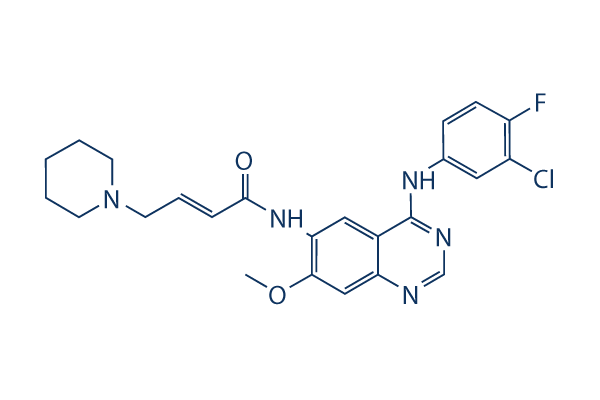
Dacomitinib Chemical Structure
CAS: 1110813-31-4
Selleck's Dacomitinib has been cited by 87 publications
Purity & Quality Control
Batch:
Purity:
99.84%
99.84
Other EGFR Products
Related compound libraries
Choose Selective EGFR Inhibitors
Cell Data
| Cell Lines | Assay Type | Concentration | Incubation Time | Formulation | Activity Description | PMID |
|---|---|---|---|---|---|---|
| PC9 cells | Function assay | 2 h | Inhibition of EGFR exon 19 deletion activating mutant phosphorylation in human PC9 cells after 2 hrs by fluorescence assay, IC50=0.63 nM | 23930994 | ||
| human LoVo cells | Function assay | 2 h | Inhibition of wild type EGFR phosphorylation in human LoVo cells after 2 hrs by fluorescence assay, IC50=0.011 μM | 23930994 | ||
| human NCI-H1975 cells | Function assay | 2 h | Inhibition of EGFR L858R/T970M double mutant phosphorylation in human NCI-H1975 cells after 2 hrs by fluorescence assay, IC50=0.042 μM | 23930994 | ||
| human NCI-H1975 cells | Proliferation assay | Antiproliferative activity against human NCI-H1975 cells assessed as growth inhibition, GI50=0.1233 μM | 26310890 | |||
| Sf9 | Function assay | 6 mins | Irreversible inhibition of GST-tagged ERBB1 (unknown origin) (Met-668 to Ala-1211 residues) expressed in baculovirus infected Sf9 insect cells assessed as reduction in Glu/Tyr copolymer phosphorylation after 6 mins by ELISA, IC50 = 0.006 μM. | 27491023 | ||
| NIH/3T3 | Function assay | 2 hrs | Irreversible inhibition of full length human ERBB1 autophosphorylation transfected in EGF-stimulated mouse NIH/3T3 cells incubated for 2 hrs followed by stimulation with EGF for 10 mins, IC50 = 0.006 μM. | 27491023 | ||
| Sf9 | Function assay | 6 mins | Irreversible inhibition of GST-tagged ERBB2 (unknown origin) (Ile-675 to Val-1256 residues) expressed in baculovirus infected Sf9 insect cells assessed as reduction in Glu/Tyr copolymer phosphorylation after 6 mins by ELISA, IC50 = 0.046 μM. | 27491023 | ||
| Sf9 | Function assay | 6 mins | Irreversible inhibition of GST-tagged ERBB4 (unknown origin) (Gly-259 to Gly-690 residues) expressed in baculovirus infected Sf9 insect cells assessed as reduction in Glu/Tyr copolymer phosphorylation after 6 mins by ELISA, IC50 = 0.074 μM. | 27491023 | ||
| Sf9 | Function assay | 30 mins | Irreversible inhibition of human recombinant GST-tagged JAK3 expressed in baculovirus infected Sf9 insect cells assessed as reduction in polyglutamic acid-tyrosine phosphorylation after 30 mins by ELISA, IC50 = 3.57 μM. | 27491023 | ||
| NIH/3T3 | Function assay | 30 mg/kg | 2 days | In vivo inhibition of full length human ERBB1 autophosphorylation transfected in NIH/3T3 cells implanted in mouse at 30 mg/kg, po qd for 2 days measured 24 hrs post last dose by Western blot analysis | 27491023 | |
| insect cells | Function assay | Inhibition of GST-tagged human EGFR catalytic domain expressed in insect cells, IC50 = 0.006 μM. | 28754471 | |||
| NCI-H1819 | Antiproliferative assay | 72 hrs | Antiproliferative activity against human NCI-H1819 cells expressing wild type HER2 incubated for 72 hrs by MTS assay, IC50 = 0.029 μM. | 28754471 | ||
| insect cells | Function assay | Inhibition of GST-tagged human HER2 catalytic domain expressed in insect cells, IC50 = 0.0457 μM. | 28754471 | |||
| NCI-H1975 | Antiproliferative assay | 72 hrs | Antiproliferative activity against human NCI-H1975 cells expressing EGFR T790M/L858R mutant incubated for 72 hrs by MTS assay, IC50 = 0.44 μM. | 28754471 | ||
| Click to View More Cell Line Experimental Data | ||||||
Biological Activity
| Description | Dacomitinib is a potent, irreversible pan-ErbB inhibitor, mostly to EGFR with IC50 of 6 nM in a cell-free assay. Dacomitinib inhibits ERBB2 and ERBB4 with IC50 of 45.7 nM and 73.7 nM, respectively. Dacomitinib is effective against NSCLCs with EGFR or ERBB2 mutations (resistant to gefitinib) as well as those harboring the EGFR T790M mutation. Dacomitinib inhibits cell growth and induces apoptosis. Phase 2. | ||||||
|---|---|---|---|---|---|---|---|
| Targets |
|
| In vitro | ||||
| In vitro | PF299804 is a specific inhibitor of the ERBB family of kinases. PF299804 inhibits EGFR signaling and induces apoptosis in the EGFR T790M-containing H3255 GR cell line. PF299804 is effective in gefitinib-sensitive and gefitinibresistant NSCLC cell lines. PF299804 inhibits the growth of H3255 and HCC827 cells engineered to express EGFR T790M. PF299804 inhibits EGFR phosphorylation in the presence of the T790M mutation. [1] PF-299804 is believed to irreversibly inhibit ERBB tyrosine kinase activity through binding at the ATP site and covalent modification of nucleophilic cysteine residues in the catalytic domains of ERBB family members. [2] PF299804 shows significant growth-inhibitory effects in HER2-amplified gastric cancer cells (SNU216, N87), and it has lower 50% inhibitory concentration values compared with other EGFR tyrosine kinase inhibitors, including gefitinib, lapatinib, BIBW-2992, and CI-1033. PF299804 induces apoptosis and G1 arrest and inhibits phosphorylation of receptors in the HER family and downstream signaling pathways including STAT3, AKT, and extracellular signal-regulated kinases (ERK) in HER2-amplified gastric cancer cells. PF299804 also blocks EGFR/HER2, HER2/HER3, and HER3/HER4 heterodimer formation as well as the association of HER3 with p85α in SNU216 cells. [3] A recent research uses forty-seven human breast cancer and immortalized breast epithelial lines to evaluate the inhibition effects of PF299804, the results indicate PF299804 preferentially inhibits growth of HER-2-amplified breast cancer cell lines than nonamplified lines (RR = 3.39, p < 0.0001). PF299804 reduces the phosphorylation of HER2, EGFR, HER4, AKT, and ERK in the majority of sensitive lines. PF299804 exerts its anti-proliferative effect through a combined G0/G1 arrest and an induction of apoptosis. [4] | |||
|---|---|---|---|---|
| Kinase Assay | ELISA-Based ERBB Kinase Assay | |||
| The ERBB1, ERBB 2, and ERBB4 cytoplasmic fusion proteins are made by cloning the ERBB1 sequence (Met-668 to Ala-1211), ERBB2 (Ile-675 to Val-1256), and ERBB4 sequence (Gly-259 to Gly-690) into the baculoviral vector pFastBac using PCR. Proteins are expressed in baculovirusinfected Sf9 insect cells as GST fusion proteins. The proteins are purified by affinity chromatography using glutathione sepharose beads. Inhibition of ERBB tyrosine kinase activity is assessed using an ELISA-based receptor tyrosine kinase assay. Kinase reactions (50 mM HEPES, pH 7.4, 125 mM NaCl, 10 mM MgCl2, 100 μM sodium orthovanadate, 2 mM dithiothreitol, 20 μM ATP, PF299804 or vehicle control, and 1-5 nM GST-erbB per 50 μL of reaction mixture) are run in 96-well plates coated with 0.25 mg/mL poly-Glu-Tyr. The reactions are incubated for 6 minutes at room temperature while being shaken. Kinase reactions are stopped by removal of the reaction mixture, and then the wells are washed with wash buffer (0.1% Tween 20 in PBS). Phosphorylated tyrosine residues are detected by adding 0.2 μg/mL antiphosphotyrosine antibody (Oncogene Ab-4; 50 μL/well) coupled to horseradish peroxidase (HRP) diluted in PBS containing 3% BSA and 0.05% Tween 20 for 25 minutes while being shaken at room temperature. The antibody is removed, and plates are washed in wash buffer. HRP substrate (SureBlue3,3,5,5-tetramethyl benzidine or TMB) is added (50 μL per well) and incubated for 10-20 minutes while it is shaken at room temperature. The TMB reaction is stopped with the addition of 50 μL of stop solution (0.09 N H2SO4). The signal is quantified by measuring absorbance at 450 nm. IC50 values are determined for PF299804 using the median effect method. | ||||
| Cell Research | Cell lines | Various NSCLC cell lines | ||
| Concentrations | 0-20 nM | |||
| Incubation Time | 72 hours | |||
| Method | Growth and inhibition of growth is assessed by 5-(3-carboxymethoxyphenyl)-2-(4-sulfophenyl)-2H-tetrazolium (MTS) assay. This assay, a colorimetric method fordetermining the number of viable cells, is based on the bioreduction of MTS by cells to a formazan product that is soluble in cell culture medium, can be detected spectrophotometrically. The cells are exposed totreatment for 72 hours, and the number of cells used per experiment is determined empirically. All experimental points are set up in 6 to 12 wells, and all experiments are repeated at least thrice. The data are graphically displayed using GraphPad Prism version 3.00 for Windows (GraphPad Software). The curves are fitted using a nonlinear regression model with a sigmoidal dose response. | |||
| Experimental Result Images | Methods | Biomarkers | Images | PMID |
| Western blot | pEGFR / EGFR / pERK / ERK / pAKT / AKT / p-mTOR / mTOR / pSTAT3 / STAT3 |
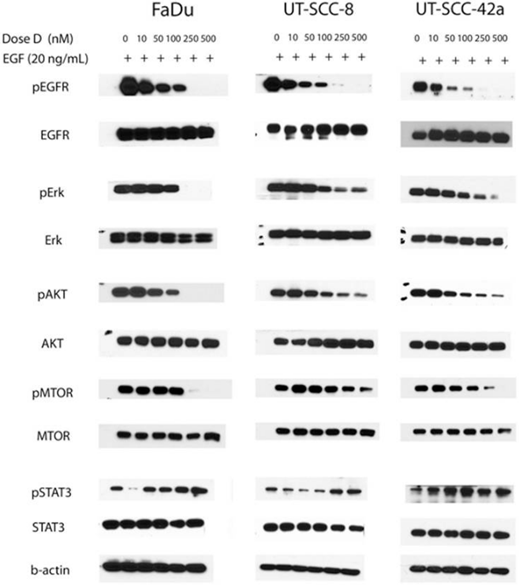
|
24853121 | |
| Immunofluorescence | LC3 |
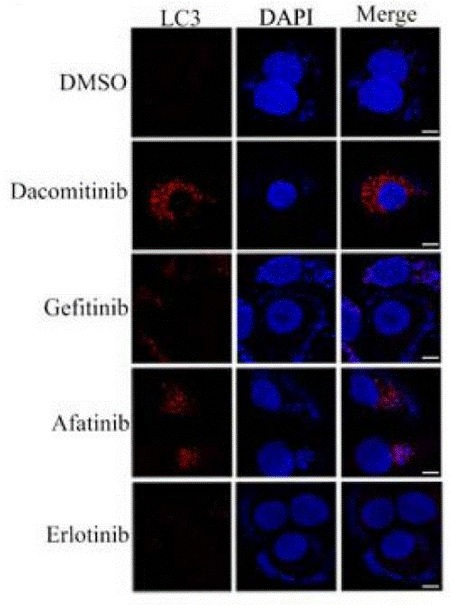
|
28366635 | |
| Growth inhibition assay | Cell viability |
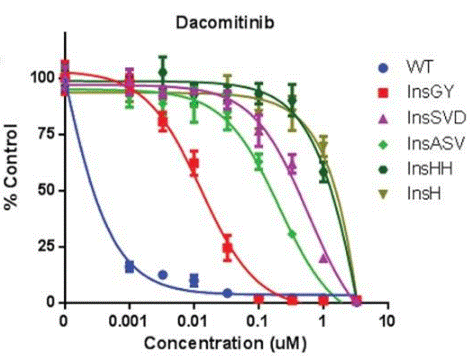
|
28363995 | |
| In Vivo | ||
| In vivo | Orally administered PF299804 effectively inhibits growth of HCC827 Del/T790M xenografts. [1] Low oral administration of PF-299804 (15mg/kg) causes significant antitumor activity, including marked tumor regressions in a variety of human tumor xenograft models that express and/ or overexpress ERBB family members or contain the double mutation (L858R/T790M) in ERBB1 (EGFR) associated with resistance to gefitinib and erlotinib. [2] | |
|---|---|---|
| Animal Research | Animal Models | HCC827-GFP or HCC827-Del/T790M lung cancer cells (in 0.2 mL of PBS) are inoculated s.c. into the lower-right quadrant of the flank of nude mice |
| Dosages | 10 mg/kg | |
| Administration | Administered via oral gavage | |
| NCT Number | Recruitment | Conditions | Sponsor/Collaborators | Start Date | Phases |
|---|---|---|---|---|---|
| NCT06075615 | Not yet recruiting | Carcinoma Non-Small-Cell Lung | Pfizer | January 15 2024 | -- |
| NCT04609319 | Recruiting | Lung Cancer | Pfizer | January 23 2021 | -- |
| NCT03865446 | Completed | Severe Hepatic Impairment | Pfizer | April 5 2019 | Phase 1 |
| NCT02382796 | Completed | NSCLC | Pfizer | July 10 2015 | Phase 2 |
| NCT02268747 | Unknown status | Skin Squamous Cell Cancer | Fondazione IRCCS Istituto Nazionale dei Tumori Milano | November 2014 | Phase 2 |
| NCT02097433 | Completed | Healthy | Pfizer | July 2014 | Phase 1 |
Chemical lnformation & Solubility
| Molecular Weight | 469.94 | Formula | C24H25ClFN5O2 |
| CAS No. | 1110813-31-4 | SDF | Download Dacomitinib SDF |
| Smiles | COC1=C(C=C2C(=C1)N=CN=C2NC3=CC(=C(C=C3)F)Cl)NC(=O)C=CCN4CCCCC4 | ||
| Storage (From the date of receipt) | |||
|
In vitro |
DMSO : 49 mg/mL ( (104.26 mM); Moisture-absorbing DMSO reduces solubility. Please use fresh DMSO.) Ethanol : 15 mg/mL Water : Insoluble |
Molecular Weight Calculator |
|
In vivo Add solvents to the product individually and in order. |
In vivo Formulation Calculator |
||||
Preparing Stock Solutions
Molarity Calculator
In vivo Formulation Calculator (Clear solution)
Step 1: Enter information below (Recommended: An additional animal making an allowance for loss during the experiment)
mg/kg
g
μL
Step 2: Enter the in vivo formulation (This is only the calculator, not formulation. Please contact us first if there is no in vivo formulation at the solubility Section.)
% DMSO
%
% Tween 80
% ddH2O
%DMSO
%
Calculation results:
Working concentration: mg/ml;
Method for preparing DMSO master liquid: mg drug pre-dissolved in μL DMSO ( Master liquid concentration mg/mL, Please contact us first if the concentration exceeds the DMSO solubility of the batch of drug. )
Method for preparing in vivo formulation: Take μL DMSO master liquid, next addμL PEG300, mix and clarify, next addμL Tween 80, mix and clarify, next add μL ddH2O, mix and clarify.
Method for preparing in vivo formulation: Take μL DMSO master liquid, next add μL Corn oil, mix and clarify.
Note: 1. Please make sure the liquid is clear before adding the next solvent.
2. Be sure to add the solvent(s) in order. You must ensure that the solution obtained, in the previous addition, is a clear solution before proceeding to add the next solvent. Physical methods such
as vortex, ultrasound or hot water bath can be used to aid dissolving.
Tech Support
Answers to questions you may have can be found in the inhibitor handling instructions. Topics include how to prepare stock solutions, how to store inhibitors, and issues that need special attention for cell-based assays and animal experiments.
Tel: +1-832-582-8158 Ext:3
If you have any other enquiries, please leave a message.
* Indicates a Required Field
Frequently Asked Questions
Question 1:
I would like to know whether the in vivo formulation you recommend is suitable for oral administration?
Answer:
S2727 in 1% DMSO+30% polyethylene glycol+1% Tween 80 at 10mg/ml is a homogeneous suspension, and it was fine for oral gavage. When preparing the solution, please dissolve the compound in DMSO clearly first. If it dissolves not readily, please sonicate and warm it at about 45-50℃ for a while to help dissolving. Then add PEG 300 and Tween 80. After they mixed well, dilute with water. Then it will become a homogeneous suspension.
Tags: buy Dacomitinib | Dacomitinib supplier | purchase Dacomitinib | Dacomitinib cost | Dacomitinib manufacturer | order Dacomitinib | Dacomitinib distributor








































